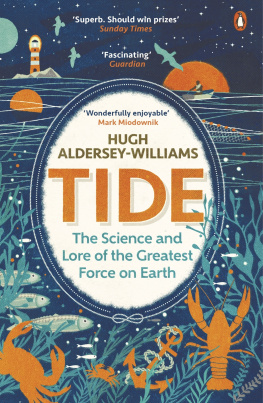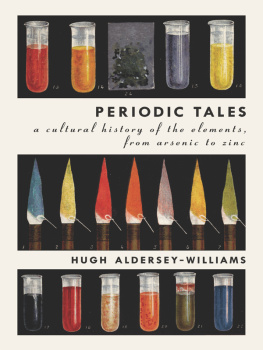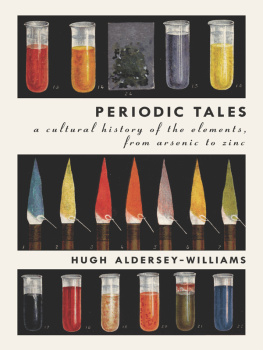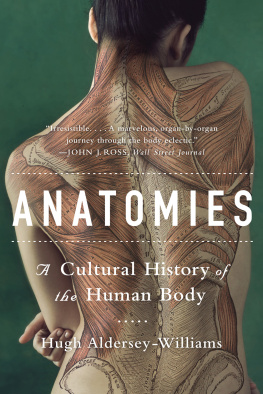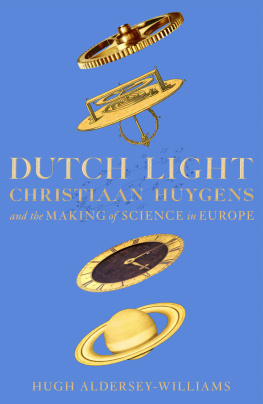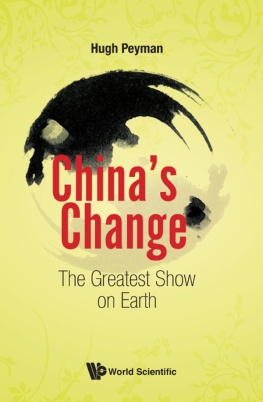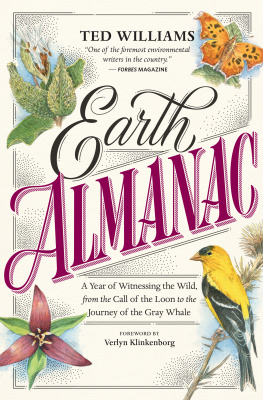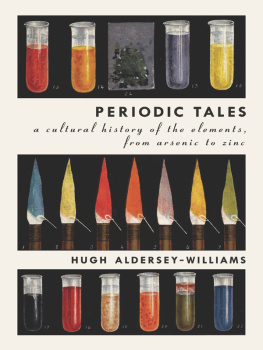Hugh Aldersey-Williams - Tide : the science and lore of the greatest force on earth
Here you can read online Hugh Aldersey-Williams - Tide : the science and lore of the greatest force on earth full text of the book (entire story) in english for free. Download pdf and epub, get meaning, cover and reviews about this ebook. year: 2017, genre: Art. Description of the work, (preface) as well as reviews are available. Best literature library LitArk.com created for fans of good reading and offers a wide selection of genres:
Romance novel
Science fiction
Adventure
Detective
Science
History
Home and family
Prose
Art
Politics
Computer
Non-fiction
Religion
Business
Children
Humor
Choose a favorite category and find really read worthwhile books. Enjoy immersion in the world of imagination, feel the emotions of the characters or learn something new for yourself, make an fascinating discovery.
- Book:Tide : the science and lore of the greatest force on earth
- Author:
- Genre:
- Year:2017
- Rating:3 / 5
- Favourites:Add to favourites
- Your mark:
- 60
- 1
- 2
- 3
- 4
- 5
Tide : the science and lore of the greatest force on earth: summary, description and annotation
We offer to read an annotation, description, summary or preface (depends on what the author of the book "Tide : the science and lore of the greatest force on earth" wrote himself). If you haven't found the necessary information about the book — write in the comments, we will try to find it.
Hugh Aldersey-Williams: author's other books
Who wrote Tide : the science and lore of the greatest force on earth? Find out the surname, the name of the author of the book and a list of all author's works by series.
Tide : the science and lore of the greatest force on earth — read online for free the complete book (whole text) full work
Below is the text of the book, divided by pages. System saving the place of the last page read, allows you to conveniently read the book "Tide : the science and lore of the greatest force on earth" online for free, without having to search again every time where you left off. Put a bookmark, and you can go to the page where you finished reading at any time.
Font size:
Interval:
Bookmark:



UK | USA | Canada | Ireland | Australia
India | New Zealand | South Africa
Viking is part of the Penguin Random House group of companies whose addresses can be found at global.penguinrandomhouse.com.

First published 2016
Copyright Hugh Aldersey-Williams, 2016
The moral right of the author has been asserted
Cover illustration Edward Bettison
Grateful acknowledgement is made for permission to reprint lyrics from Pipe Dream. Copyright 1955 by Richard Rodgers and Oscar Hammerstein II. Copyright Renewed by Williamson Music (ASCAP), an Imagem Company, owner of publication and allied rights throughout the World. International Copyright Secured. All Rights Reserved. Used by Permission
ISBN: 978-0-241-96800-0

discover more stories like this at Penguin.co.uk
The Most Beautiful Molecule
Findings
Panicology (with Simon Briscoe)
Periodic Tales
Anatomies
The Adventures of Sir Thomas Browne in the 21st Century
To John
It is advisable to look from the tide pool to the stars and then back to the tide pool again.
John Steinbeck, The Log of the Sea of Cortez
In general, I use metric (SI) units, especially when discussing scientific measurements. But I also use familiar units where to do otherwise would seem perverse. Some units the foot, the mile have a rightness about them that transcends international systems of measurement.
1 knot = 1 nautical mile per hour = 1.15 statute miles per hour = 1.85 kilometres per hour = 0.51 metres per second.
Historical tide data given at the head of various chapter sections is calculated using the United Kingdom Hydrographic Office Admiralty Easytide website, www.ukho.gov.uk/easytide, except the data for Dover, which is from the source indicated in that chapter, and Stockholm, which is from Martin Ekman.
Dates are generally given according to contemporary records, but tidal calculations for Old Style dates have been adjusted.
Halfway along the causeway that crosses the sandflats and marshes to the holy Northumbrian island of Lindisfarne, with its ancient priory and castle, is a little refuge, a hut built on stilts with wooden steps up to the door. Notices fixed to the door state the purpose of this odd structure. It is there for the use of unwary travellers who find themselves caught out on the three-mile crossing by the rising tide. Among the notices is a sun-bleached cartoon from a local newspaper. It shows a family huddled together on the roof of their car as the rising seawater begins to lap at its windows. The caption has one parent complaining to the other: I didnt think that tides applied to tourists.
On the islands of Britain, we live surrounded by water that rises and falls according to rules that are a mystery to almost all of us. We are adrift on a sea whose movements we do not understand. Many are the summers on the stretch of coast where I live in Norfolk that a child is swept out to sea on the tide, to be washed up dead days or months later many miles along the coast. Half of the worlds population lives in coastal regions lapped by tidal waters, and yet, unless we depend directly upon the ocean for our living, we remain inattentive to its strange rhythms and ignorant of their complicated causes.
We do not understand, therefore, why the pleasure boat trip cannot depart on the Sunday morning that would fall in best with our weekend plans. We do not understand why and flow of great oceans to create the conditions under which the correct chemical ingredients could mingle to produce the first primitive organisms.
The tide? Whats that got to do with the price of fish? Well, a very great deal as it happens. The American variant of this expression is: Whats that got to do with the price of tea in China? Well, the tide may not much affect the price of tea in China, but it has been important in determining the price of Chinese tea, for in the days when tea clippers raced round the Cape of Good Hope to be first to bring the new-picked leaves to London or Boston, the state of the tide as they closed upon their port of destination could decide the winner, who was then able to sell his cargo at a premium. The tide has always influenced where important marine resources are concentrated; and over the centuries, the tide has often been a hidden factor in determining the location of great ports and in governing their subsequent success in commerce.
My own formative encounter with the tide happened in waters just off the coast of the Isle of Wight, a locale of such comical tameness, lapping an ice-cream island of garden gnomes and miniature railways, that it still amazes me years later that we could have been in mortal danger.
We were sailing from Weymouth to Yarmouth in the wooden boat that my father had hand-built over a period of twelve years. Over the ground, the distance was thirty miles or so, which would be a full days sailing in our small craft. The journey would take us eastward along the Dorset coast past the Isle of Purbeck and Bournemouth and then up the Needles channel into the Solent. The Needles channel was a tricky stretch of water, bounded by a gravel bank known as the Shingles on one side and by the jagged promontories of the Isle of Wight on the other. The tide runs fast, especially at Hurst Point where a spit juts out from the mainland, forcing the waters through a gap less than a mile wide.
It is also one of the worlds busiest shipping lanes, and for this reason has been generously strewn with navigation buoys red ones to denote the port side of the channel, green ones for starboard and others known as cardinal marks that indicate the location of isolated underwater obstructions. None of these markers in the least resemble the squashy plastic buoys you see used for moorings in sheltered waters. They are placed by Trinity House, the national authority responsible for safe signposting at sea, and are substantial objects to find floating in the water. The cardinal marks in particular are imposing steel structures, tall gantries rising to the height of a double-decker bus above the waves, with just as much ironwork hidden below the waterline in buoyancy compartments and ballast. Some three metres in diameter and weighing six tonnes, they are not the kind of thing you argue with in a vessel of any size, and certainly not in a small wooden yacht.
Font size:
Interval:
Bookmark:
Similar books «Tide : the science and lore of the greatest force on earth»
Look at similar books to Tide : the science and lore of the greatest force on earth. We have selected literature similar in name and meaning in the hope of providing readers with more options to find new, interesting, not yet read works.
Discussion, reviews of the book Tide : the science and lore of the greatest force on earth and just readers' own opinions. Leave your comments, write what you think about the work, its meaning or the main characters. Specify what exactly you liked and what you didn't like, and why you think so.

